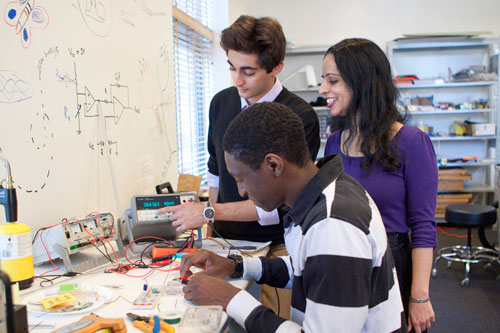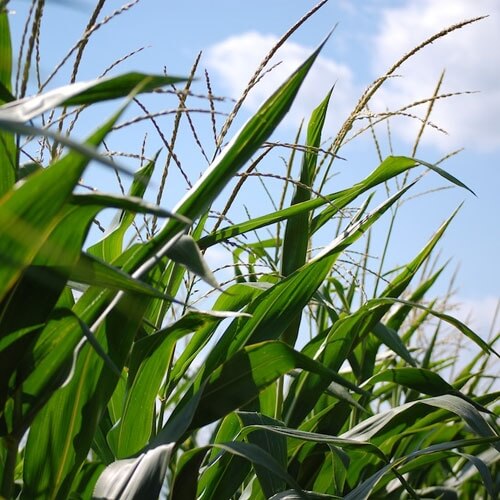News
Corn-derived nanotubes can enhance the electrical conductivity of gels that are used to regrow neural and cardiac tissue. Photo courtesy of Flickr user Vistavision.
By Mureji Fatunde ‘12

Students in the undergraduate teaching labs at SEAS are investigating plant-based materials that may help regrow damaged neurons. Front to rear: Godwin Abiola '14; Sujata Bhatia, Assistant Director for Undergraduate Studies in Biomedical Engineering; and Erfan Soliman '12.
One might expect, these days, to find corn products in food, fuel, and fabric, but a corn-based glue that can heal an injured eyeball? That's a-maize-ing.
Creating new materials from abundant, natural plant sources, today’s biomedical and biochemical engineers are finding clinical uses for new "custom" materials that were not even remotely considered in recent decades.
Both renewable and remarkable, plant-based medical products are on the cutting edge of a field called "sustainable biomaterials," a topic so intriguing that 23 undergraduates chose to spend an extra week at the Harvard School of Engineering and Applied Sciences (SEAS) to take a course on it during their winter break.
“It was engaging, comprehensive, and demonstrated just how 'sexy' science can be," said Aubrey Walker '15.
The seminar-style mini-course was led by Sujata Bhatia, Assistant Director for Undergraduate Studies in Biomedical Engineering, who arrived at SEAS last spring. As an industry scientist at DuPont, Bhatia had been at the forefront of research resulting in clinically relevant products, including plant-based tissue adhesives. She now brings that expertise to guide an agile and modern curriculum at SEAS.
Bhatia, who received a grant from the Harvard President’s January Innovation Fund for Faculty to offer the course, intended it as a “vehicle to really get undergraduates thinking about their paths in engineering, and to give a broader overview than they might get in any single course during the semester."
"I hope that this will both draw undergraduates into the concentration and give concentrators the tools necessary to begin asking their own questions within the field,” she said.
For Walker, a freshman, the course was an inspiring introduction to the breadth of opportunities available in engineering.
“Through the lens of a bioengineer, I felt myself at the precipice of innovative solutions to some of our generation’s biggest problems," he said. "I can’t imagine a more concise, intellectually stimulating, or rewarding program. I am very glad to have come back from my long break to gain this experience.”
During the week, the students attended foundational lectures on biomaterials and new methods of drug delivery. They also had the opportunity to survey some of the current research in the field by attending the Bio-inspired Engineering International Symposium, which was hosted by Harvard’s Center for Nanoscale Systems on January 17.
Brandon Geller and Robyn Tsukayama of the Harvard Office for Sustainability gave a guest lecture on biopolymers, giving students insight into the strides that the University is making to integrate the fruits of bioengineering research into its operations.
In addition to seeing the work of experts in the field, students were able to learn about research that their classmates are undertaking. Seniors in engineering, including Erfan Soliman ’12, led one of the week’s sessions by discussing their thesis research and introducing the groups to the laboratory and design spaces that are available to students at SEAS.

For his ES 100 design project, Erfan Soliman '12 is developing a plant-based substrate that may help regrow neural tissue. Corn-derived carbon nanobrushes in agar form an electrically conductive gel that stimulates the growth of neural cells.
Soliman's work, which combines agar gel and corn-derived carbon nanotubes into a substrate for neural regeneration, extends far beyondthe traditional boundaries of his own concentration, electrical engineering.
In addition to presenting a poster at the Bio-inspired Engineering Symposium, Soliman was able to connect with other students, across disciplines. He teamed up in the lab with Godwin Abiola ’14, a biomedical engineering student, in January, teaching him about circuit theory in order to measure the electrical conductivity of the agar gels.
The partnership between Soliman and Abiola is typical of a trend of collaboration at SEAS that Bhatia believes is here to stay.
"It's very powerful, and it helps students appreciate early on the importance of bringing diverse perspectives to a project," she said. "I've always been interested in the interfaces between different disciplines. That's where all the cool things can happen."
Topics: Health / Medicine, Bioengineering
Cutting-edge science delivered direct to your inbox.
Join the Harvard SEAS mailing list.



